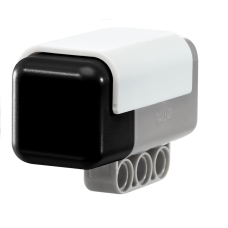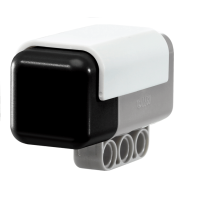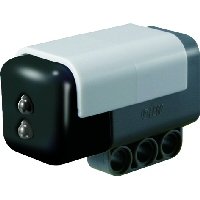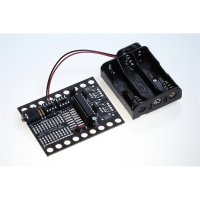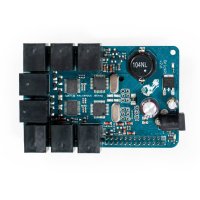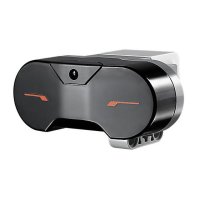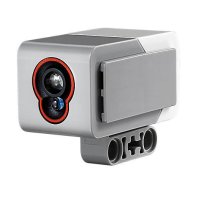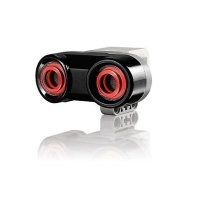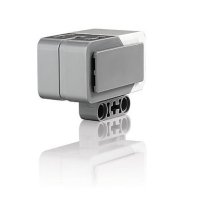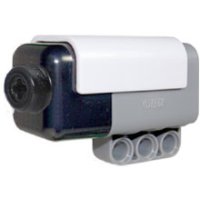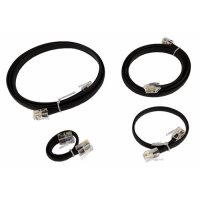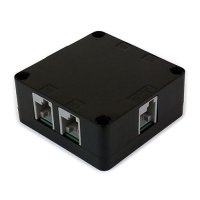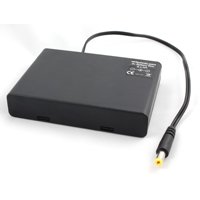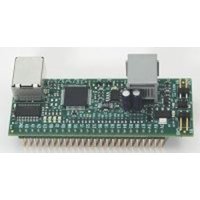


- Choose the port your EOPD is plugged into. By default, the block will be set to port 1 for the EOPD. You can change this selection if you want.
- Use the slider to set the trigger value or type a value directly into the input box. Select the radio button to the right of the slider if you want the block to be triggered by levels higher than the trigger value; select the left radio button to trigger the block with levels lower than the trigger value. You can also use the pull-down menu to set the �true� portion of the slider.
- If you check the �Long Range� checkbox, the EOPD sensor will adjust the sensitivity to detect objects over a longer distance.
- EOPD block Data Hub plugs

- This plug wires the NXT port number your EOPD is connected to.
- This plug wires the value to compare against for the trigger.
- This plug wires the logic used in the trigger comparison.
- This plug wires the Long Range selection.
- This plug wires the result of the trigger comparison.
- This plug wires the processed value from the sensor.
- This plug wires the raw value from the sensor.
- Examples showing the logical result.
|
|
Plug | Data Type | Possible Range | What the Values Mean |
|
1
|
Port | Number | 1, 2, 3 or 4 | NXT sensor port the EOPD is plugged into |
|
2
|
Trigger Point | Number | 0 - 1023 | Value to compare against |
|
3
|
Greater / Less | Logic | True/False |
Logic used in comparison. True = Greater, False = Less |
|
4
|
Long Range | Logic | True/False |
Select Long Range Mode True = Long Range, False = Standard Range |
|
5
|
Yes / No | Logic | True/False | Result of comparison |
|
6
|
Result | Number | 0 - 100 | Processed or scaled value read from sensor. This is useful to calculate a relative distance * see note |
|
7
|
Raw Value | Number | 0 - 1023 | Raw (unscaled) value read from sensor |
Lego Mindstorms NXT EOPD
- Brand: HiTechnic
- Product Code: Hitechnic-NXT-EOPD
- Reward Points: 69
- Availability: In Stock
-
रo 6,920.00
- Price in reward points: 6920
Related Products
Lego Mindstorm Acceleration / Tilt Sensor for NXT / EV3
Now you can make robots that know which way is up! The Accelerometer / Tilt Sensor measures accelera..
रo 6,920.00 रo 7,550.00
Lego Mindstorms Magnetic Compass Sensor for NXT / EV3
Expand your NXT experiences with the new NXT Compass Sensor and add accurate navigation to your Mind..
रo 7,385.00 रo 7,550.00
Lego Mindstorms Infrared Seeker V2 for NXT / EV3
Play robot soccer and zero in on your infrared (IR) beacons with IRSeeker. You can use most TV remot..
रo 6,920.00 रo 6,985.00
Lego Mindstorms Color Sensor V2 for NXT / EV3
Add a spectrum of color to your models with the new and updated Color Sensor. Detect an extended ran..
रo 6,920.00 रo 7,550.00
PICAXE I2C Explorer Kit AXE216
A self-assembly kit for the PICAXE-20X2 (included) for those wishing to interface and experiment wit..
रo 1,350.00
BrickPi+ Base Kit
BrickPi is best for someone who already has LEGO MINDSTORMS sensors and motors. The BrickPi connects..
रo 17,563.00
EV3 Infrared Beacon
This has been designed for use with the EV3 Infrared Seeker Sensor. The beacon emits an infrared sig..
रo 4,425.00
EV3 Infrared Sensor
The digital EV3 Infrared Seeking Sensor detects proximity to the robot and reads signals emitted by ..
रo 4,425.00
EV3 Color Sensor
The digital EV3 Color Sensor distinguishes between eight different colors. It also serves as a light..
रo 5,175.00 रo 5,885.00
EV3 Ultrasonic Sensor
The digital EV3 Ultrasonic Sensor generates sound waves and reads their echoes to detect and measure..
रo 4,425.00
EV3 Gyro Sensor
The digital EV3 Gyro Sensor measures the robot’s rotational motion and changes in its orientation. S..
रo 4,425.00
Lego Mindstorms NXT Magnetic Sensor
The NXT Magnetic Sensor will enable you to build robots that can detect magnetic fields. The sensor ..
रo 2,865.00
Lego Mindstorms NXT IR Receiver Sensor
The NXT IRReceiver Sensor receives signals from a LEGO Power Functions IR remote control, decodes th..
रo 6,280.00
Lego Mindstorms NXT Angle Sensor
Measure axle rotation position and rotation speed with the HiTechnic Angle Sensor. The Angle Sensor ..
रo 6,920.00
Lego Mindstorms NXT Force Sensor
The NXT Force Sensor will enable you to build robots that can measure a physical force applied throu..
रo 5,000.00
Lego Mindstorms NXT Barometric Sensor
The NXT Barometric Sensor can be used as part of a weather station or to monitor altitude. The senso..
रo 6,920.00
HiTechnic NXT Extended Connector Cable
Extend your Mindstorms NXT robotic designs with the HiTechnic Extended Connector Cable . Build creat..
रo 100.00
HiTechnic NXT Touch Sensor Multiplexer
HiTechnic NXT Touch Sensor Multiplexer for LEGO Mindstorms NXT Introduction The NXT Touc..
रo 3,610.00
HiTechnic 9V-6xAA Battery Box
This Battery Box can be used to power the 360 IR Beacon replacing the beacon's optional 9v internal ..
रo 645.00
HiTechnic NXT SuperPro Prototype Board
HiTechnic SuperPro Sensor for LEGO Mindstorms NXT Introduction The HiTechnic SuperPro Sensor..
रo 3,400.00
Tags: NXT, EOPD, Sensor, Lego, Mindstorms

